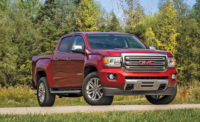New GM Midsize Pickups Clock In for Work


Driving the new 2015 Chevrolet Colorado and GMC Canyon small pickups reveals that General Motors has put to good use its three years away from this segment.
These models have grown substantially in every direction, making them 5.5 in. taller, 6.7 in. wider and 20 in. longer than before. One upside is that they can finally be considered midsize pickups, enabling them to stand toe-to-toe with their remaining rivals: the Toyota Tacoma, Nissan Frontier and Honda Ridgeline.
GM addresses the commercial-pickup users' needs with practical base models and useful options, including a speedy 4G LTE Wi-Fi hot spot, perfect for contractors on the go. With details like fully boxed, high-strength, steel-frame rails, these haulers are now solid enough to be taken seriously as work trucks.
Under the hood, two new engines are more powerful and fuel-efficient than their predecessors. A 2.5-liter four-cylinder puts out a respectable 200 horsepower and 191 lb-ft of torque and is standard in all extended-cab models. An optional 3.6-liter V6 produces 305 hp and 269 lb-ft. Look for a third power-train option, a 2.8-liter turbo-diesel four, to join the lineup next year.
A six-speed manual gearbox is offered on extended-cab base models with the four-cylinder engine. Most of the range gets a six-speed automatic that incorporates a handy tow-haul mode. Rear-wheel drive is standard, but an electronically controlled, four-wheel-drive system is optional. An automatic-locking rear differential is also available.
While the forthcoming turbo-diesel undoubtedly will raise the fuel-economy bar, the current engines already make the Colorado and Canyon the most fuel-efficient midsize pickups on the market. Mated to the automatic transmission and rear-wheel drive, fuel economy estimates for the 2.5-liter place it at 20 miles per gallon in the city/27 mpg on the highway. The new V6 reaches as high as 18/26 mpg, which is impressive when you consider they're nearly identical to those of the previous generation's 185-hp four-cylinder base engine. The Toyota Tacoma gets, at best, 18/24 mpg, while the Nissan Frontier achieves up to 17/23 mpg.
Switching from drums to rear disc brakes helps enhance performance and standard safety features, such as antilock braking and electronic stability control. Speaking of safety, the new models come with six air bags, including side-impact air bags for front-seat occupants and full-length, side-curtain air bags. Properly equipped four-cylinder models can tow up to 3,500 lb, while V6 towing capacity maxes out at 7,000 lb. Trailer sway control is also standard.
Behind the wheel, the V6 feels up to the task of working for a living, whether it is hauling tools or towing a good-size trailer. Handling is solid, and ride quality is firm. A super-quiet cabin mimics the full-size Chevrolet Silverado's and GMC Sierra's interior styling and materials. If you need to go off-road, a low-hanging front air dam is easily removed, but a modest 8.4 in. of ground clearance is appropriate mainly for light-duty treks.
Extended cabs have cramped rear jump seats—except on base trim models, which have no rear seats—and come with a 6-ft, 2-in. long bed. Crew cabs feature four full-size doors and a roomy back seat; buyers can choose a long bed or a 5-ft, 2-in. short bed. A regular cab is no longer available. The long bed is 2-in. deeper, making the tailgate longer, so a standard sheet of plywood fits above the wheel wells without sticking out the back.
GM's new small trucks are worthwhile choices for firms that view fuel economy as a top priority and need to access jobsites where space is at a premium. However, they are competing for attention in a larger pool of options, such as small sport-utility vehicles that now appeal to this segment's traditional base of surveyors, inspectors and other light-duty users. Ongoing fuel-economy gains in the full-size truck segment also enable firms to reduce operating costs without giving up all the advantages of a larger truck.



